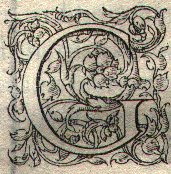
 |
 238 K |
John, of Garland, ca. 1195-ca. 1272. Synonima magistri / Johannis de garlandia cu [London : Wynkyn de Worde, ca. 1505] [52] leaves 18 cm. Worde, Wynkyn de, d. 1534?, printer. 474 J62s |
| William Caxton, the first Enlish printer, was succeeded by his foreman, Wynkyn de Worde, in 1491. The type face, as was common among early English printing, was heavy and manuscript based. All early English printing, from equipment to style, was influenced by the Continent, but it would be many decades before the Italian type faces were brought into use. | |
 250 K |
Le rommant de la rose. Nouvellement imprime a Paris. [Paris, Michel Le Noir, 1515] [156] leaves : illus. ; 18 cm. Le Noir, Michel, d. 1520, printer. 841.1 R758 1515 Other links: Image of printer's device |
| Michel Le Noir was active from the late 15th century, his business being taken over by his son Philippe upon his death. This text uses the heavy manuscript style type and also has woodcuts throughout. It is a fine example of the effort to print literature instead of the classics or religious texts. | |
 355 K |
Froissart, Jean, 1338?-1410? The Cronycles of Englande, Fraunse, Spayne, Portyngale, Scotlande, Bretayne, Flauders and other places adioynynge. Translated out of Frenche into our maternall Englysshe tonge, by Johan Bourchier Knight Lorde Berners ... [London, Richarde Pynson, 1523-1525] 2 v. 31 cm. Pynson, Richard, d. 1530, printer. 940.17 F929cEb Oversize |
| Richard Pynson, born in France, was one of the successors to Caxton and de Worde. This was the first publication an English translation of Froissart's Chronicles. Typographical errors and damaged type were far from uncommon and can be indicators of the different issues (changes after a press run) or states (changes during a press run) of books. | |
 176 K |
Boccaccio, Giovanni, 1313-1375. Ameto over comedia delle nimphe Fiorentine, compilata da Messer Giovanni Boccaccio da certaldo citta di no di Firenze. In Vinegia per Melchione Sessa, 1534. 92 numb. l., [1] 16 cm. Sessa, Melchoirre, fl. 1506-1549, printer. 853.1 B664a 1534 Other links: Images of printer's device |
| In the middle of the 16th century, Italian presses were producing great quantities of popular literature. Books were no longer as expensive as earlier and these small format volumes were designed to be read as easily in a carriage as a salon. Italic type was almost exclusively used for the titles. Note the "i" and "m" ligature. | |
 328 K |
Giovio, Paolo, 1483-1552. De vita et rebus gestis II vicecomitum mediolani principum. Vitae dvodecim Vicecomitvm Mediolani principvm. Lvtetiae [Paris], Ex officina R. Stephani, 1549. 199 p. ports. 25 cm. Tory, Geoffroy, 1480-1533, engr. Estienne, Robert, 1503-1559, printer. 920.045 G514v Other links: Image of printer's device |
| The Estienne family is another dynasty of scholar/printers who had a wide influence over the intellectual climate of their times. In 1550, fearing charges of heresy and not wishing to be quite literally burned at the stake by a bonfire made of his books, Estienne established himself in Geneva. This particular volume brings together much of the best of French printing of the time: type by Claude Garamond with initials and engravings by Geoffroy Tory. | |
| 15th Century | 16th Century | 17th Century | 18th Century | 19th Century | 20th Century | Home |